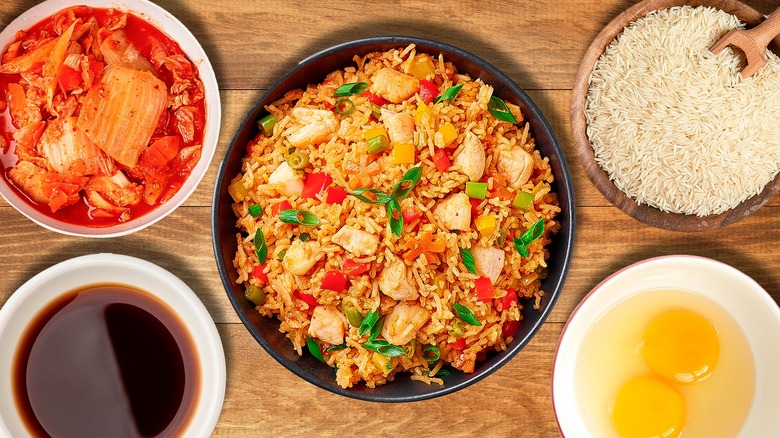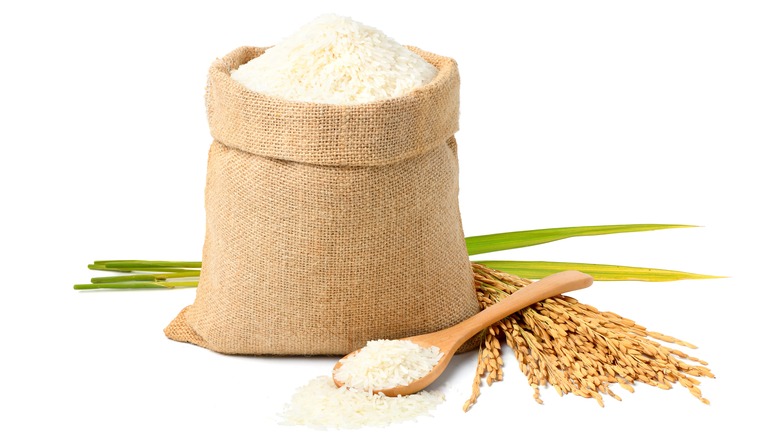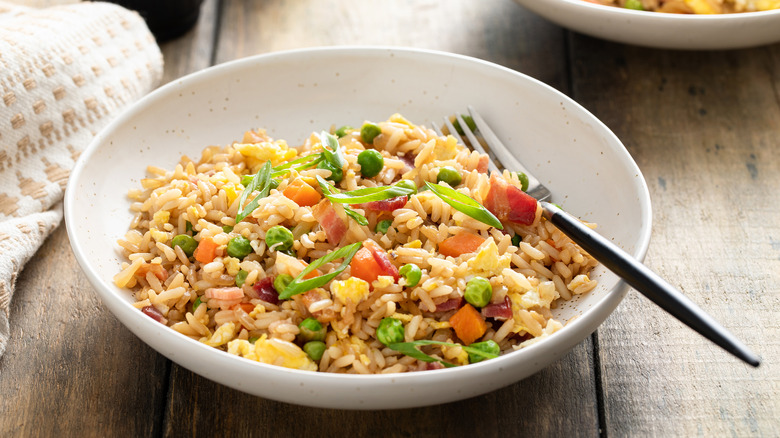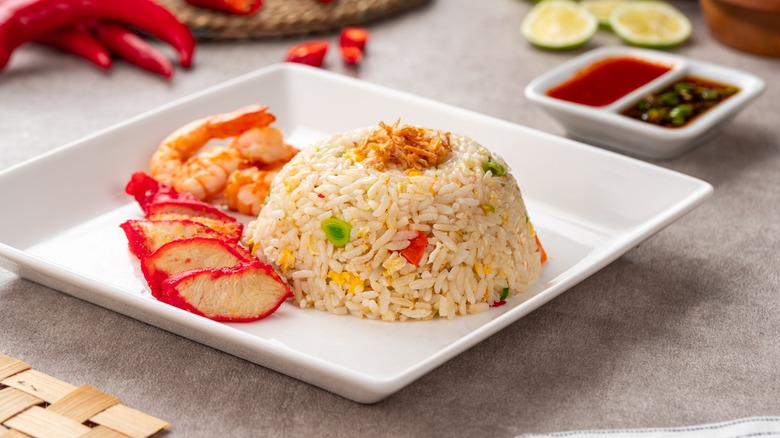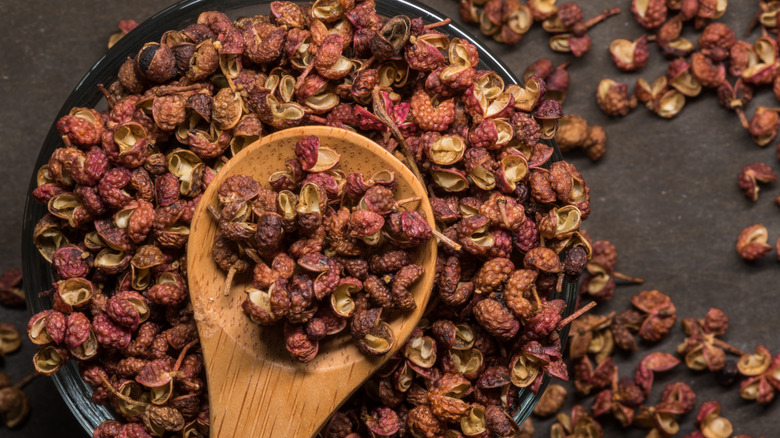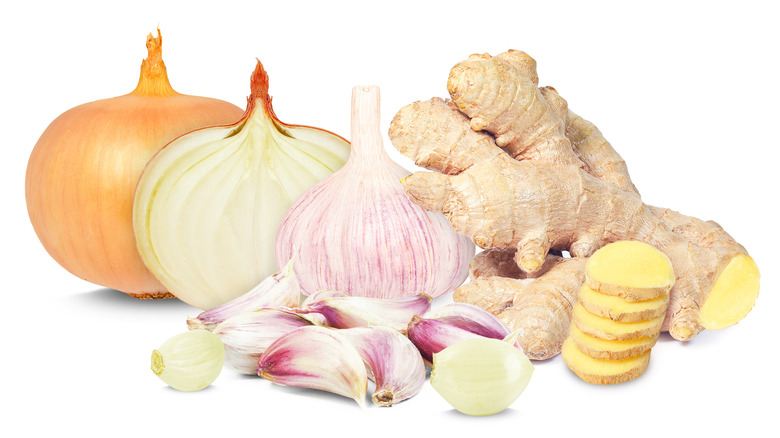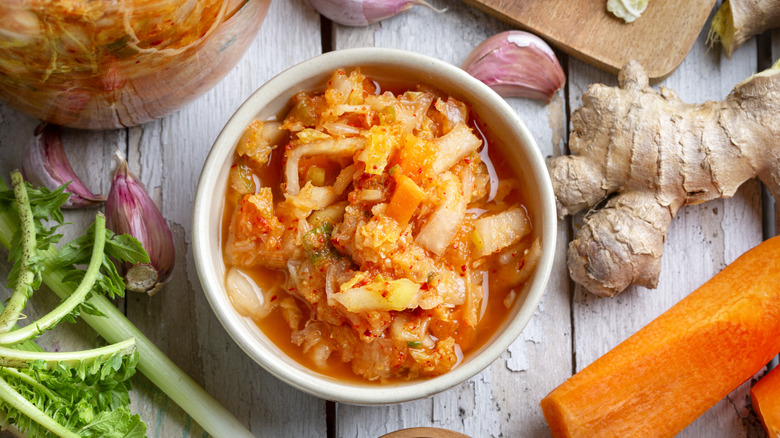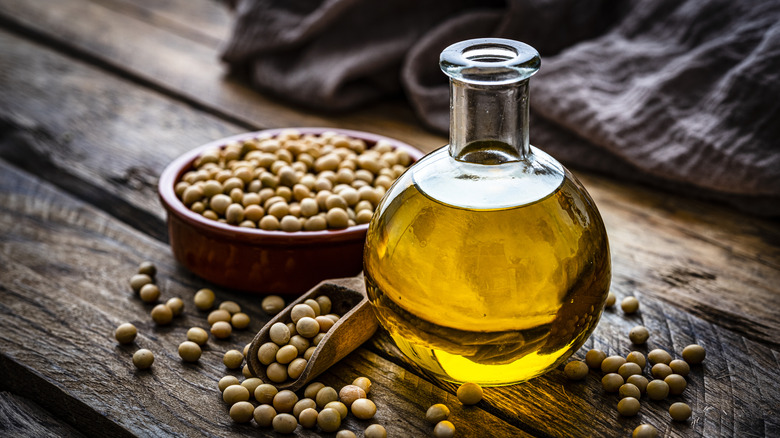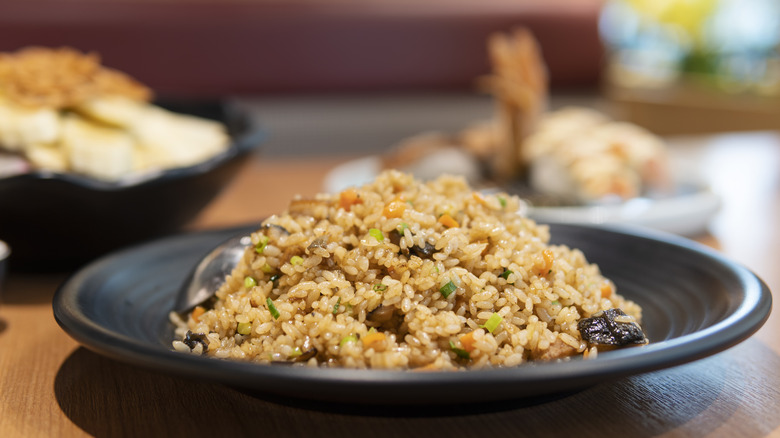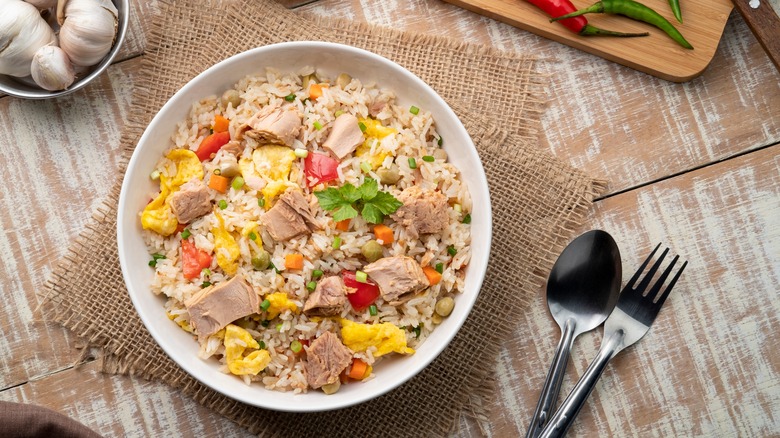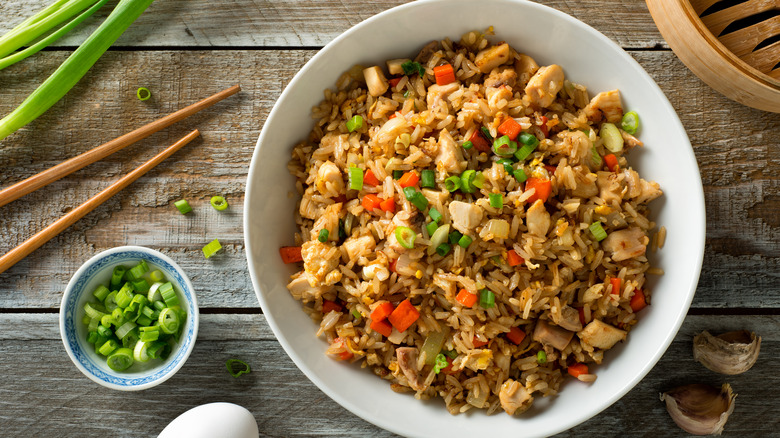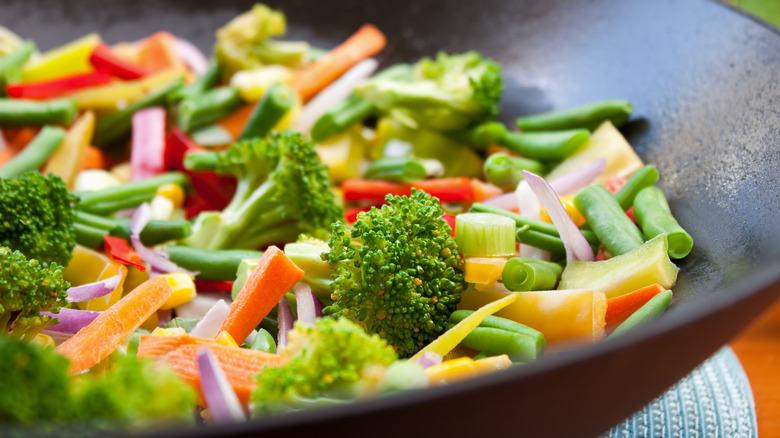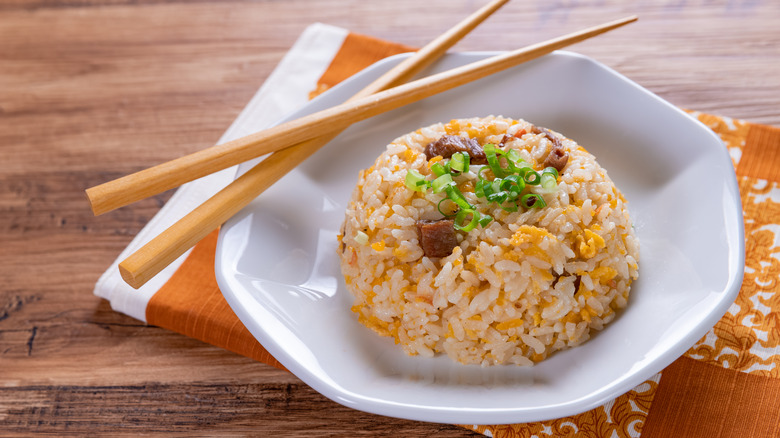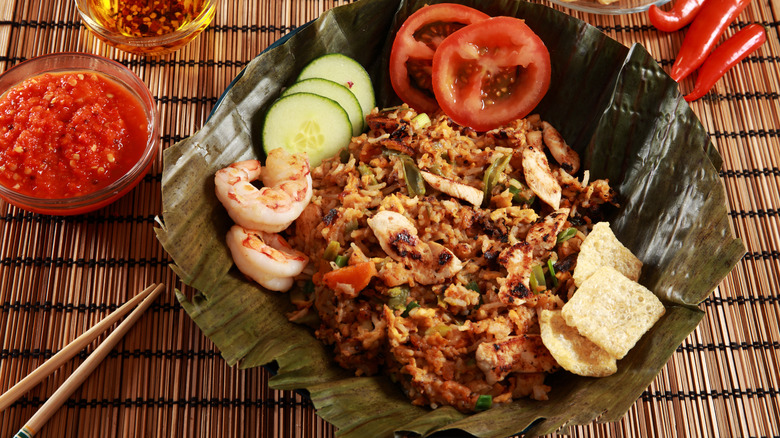Key Ingredients Trained Chefs Say You Should Put In Fried Rice
Fried rice, a delicious dish known across the globe, features stir-frying cooked rice in a hot wok or frying pan with various ingredients like vegetables, meat, seafood, eggs, and seasonings. Fried rice originated in ancient China, some say during the Sui Dynasty between 589 and 618 AD and eventually spread to many other regions. Indonesian, Thai, and other cuisines of Southeast Asia include variations of fried rice that originally came from China, and countries as far away as Nigeria and Peru have created their own takes on this warm and comforting food.
Fried rice is considered a simple dish to make, but it's not easy if you don't know what you're doing. Technique matters of course, and so do ingredients, which must be chosen and prepared carefully for appetizing results. To shed some light on the most important ingredients for fried rice, we reached out to chef Paul Yan, owner and head chef of Tres Yan and Wu Chinese restaurant in Mount Laurel, NJ. Yan, who has been cooking since the age of six, is from Guangdong, China and moved to Hong Kong at a young age. As such, his cooking is Cantonese-style, which differs from cuisines of Northern China and other parts of Asia. His responses have been translated by his daughter Paula Yan, who is also the restaurant manager.
While you can always order takeout, following these key ingredient tips can help you make restaurant-style fried rice in the comfort of your own home.
Rice
With all the rice varieties on the market, it may be confusing to know which kind to use for fried rice to achieve the right amount of moisture and texture. Chef Paul Yan says that long-grain rice is best, and his preference is Jasmine rice. This follows the Chinese tradition of making fried rice on the drier side.
While medium-grain rice can be acceptable for fried rice, the Chinese style typically avoids short-grain varieties because they retain more moisture and get clumpy and sticky. On the other hand, Japanese-style fried rice uses Japanese short-grain rice, and the final result is intentionally moist and sticky. Since regional preferences vary, choose the grain length that fits your recipe.
Apart from the rice selection, Yan's daughter, Paula Yan, believes the secret to absolutely delicious-smelling fried rice is to make sure the pan gets hot enough for the rice to develop something called wok-hei, which she translates to "aroma of the wok." In fact, this may be the reason why fried rice tastes better at a restaurant than at home. Both the woks and restaurant-grade gas ranges that reach high heats as well as the specialized tossing techniques used by professional chefs create a Maillard reaction responsible for wok hei, which is characterized by not just a delectable aroma but heightened browning, crispiness, and flavor that normally can't be achieved at home.
Leftover rice
Fried rice is made with rice that's already cooked, so don't try to make it with uncooked rice — it just won't work. Paul Yan says the cooked rice should be leftover and cold — never use freshly made hot rice — and it's fine if it's a few days old. His reason is that cold long-grain rice gives the final dish a better texture. It won't get mushy once it's cooked like hot rice will, and the grains of rice will remain separate and not clump together. As a bonus, he says the fried rice will look better too. We know that's important since the appearance of our food can do a lot to increase our appetites.
Cooling cooked rice overnight in the refrigerator is a good way to achieve the ideal texture in the dish. As it slowly cools, the starch in the rice undergoes a process called retrogradation, which causes the rice to release water and firm up, and this drier rice won't form mushy clumps. This means you'll have to plan ahead to make sure your rice isn't too fresh when you're ready to break out the wok. It also gives you a good reason to use leftover rice that you didn't know what to do with.
Liquid seasonings
Liquid seasoning can be an important tool in heightening the aroma and flavor of fried rice, but since it's important to keep fried rice on the drier side, make sure you don't use too much. Excess cooking liquid can make the ingredients steam in the wok instead of fry.
Chef Paul Yan seasons his fried rice with salt instead of soy sauce, which he says is used in Americanized versions of fried rice. As a result, his fried rice is white, not brown.
Depending on your recipe and what style of cooking is featured, you may encounter different kinds of liquid seasonings. Besides soy sauce, recipes may call for oyster sauce, fish sauce, and even Worcestershire sauce in recipes from Osaka, Japan. Some recipes use mirin as a secret fried rice ingredient. This fermented rice wine adds a touch of sweetness and, since the alcohol evaporates, it won't make the rice wet. As far as spicy ingredients, Yan says it depends on your personal preference and recommends adding hot chili oil or your favorite hot sauce when stir-frying the rice.
Dry seasonings
Dry seasonings are also a matter of your own liking or regional style. Paul Yan likes to use Cajun spice or curry powder in his versions. Your recipe may recommend different kinds of seasonings, but in addition to the two recommended by Yan, common dry spices include garlic powder, onion powder, black pepper, red pepper flakes, and of course, salt.
Some seasonings are region-specific. Sichuan peppercorns are a unique spice often used in Sichuan-style fried rice. They have a mild intensity and a subtle citrus flavor. Japanese fried rice may feature katsuobushi, a form of cured, shaved, and crunchy skipjack tuna, which is known as bonito in Japanese. These umami-rich bonito flakes are a common ingredient in Japanese dishes, likened to salt and pepper in American cuisine. Japanese cooks may also include dried strips of nori, a type of seaweed. Nigerian fried rice features spices like turmeric, curry powder, thyme, black pepper, and chili powder alongside meat, seafood, and vegetables cooked in broth or coconut milk.
While it isn't a spice, cornstarch is a dry ingredient that is sometimes sprinkled on dry rice before it's added to the wok. It helps break up the rice into individual grains and keep them separate throughout the process.
Aromatics
One secret to making restaurant-quality fried rice at home is using aromatics. Common aromatics for fried rice include garlic, ginger, red pepper, scallions, and lemongrass. Paul Yan highlights onions and scallions as his personal favorites for fried rice. As the name implies, aromatics give special aromas to the dish, but they also add complexity to flavor.
It's not enough to simply include aromatics, it's also important to know how to use them. For the best flavor, cook aromatics in hot oil at the beginning of the process before adding any other ingredients. The aromatics will infuse the oil with flavor, and the oil will act as an excellent carrier of this flavor once tossed with the other ingredients, which is why you won't get the same depth of flavor if you add the aromatics later.
While fried rice is cooked on high heat, you can keep the aromatics from burning by cooking them on a lower heat for this first step of the process. It takes different amounts of time to transfer flavor into the oil, so give onions about five minutes, garlic two to three, and ginger and dried chili peppers just 30 seconds in the oil before moving on to the next step of the recipe.
Fermented ingredients
Fermented ingredients are no strangers to fried rice, and like seasonings, these ingredients range by region. Naem, a fermented pork sausage used in Southeast Asia, is made from chopped pork that's left to cure and sour for several days at room temperature. Although it's often served as a raw appetizer, it can be found as an ingredient in Thai fried rice. Pla som, or fermented carp, is another ingredient sometimes seen in Thai fried rice. Other fermented ingredients like miso paste and tempeh make an appearance in various recipes.
A unique and popular fermented ingredient is kimchi, a Korean dish made from salty fermented vegetables — often cabbage — and other ingredients like ginger, herbs, chili flakes, and fish sauce. Kimchi fried rice has been eaten in Korea for thousands of years. You can opt to save leftover kimchi juice to add to fried rice or include the kimchi itself as a vegetable in the dish. The juice will be more flavorful if it's from kimchi that's aged at least two weeks, because kimchi ferments more over time, and the sour, tangy, umami flavor will become more pronounced. Kimchi fried rice often includes bacon and gochujang, a spicy Korean chili paste also made with fermented ingredients, in this case, soybeans.
Oil
Since fried rice is cooked with high heat, it's important to choose an oil with a high smoke point when choosing the best oil for fried rice. Some choices are peanut oil, canola oil, and unrefined avocado oil. Otherwise, the oil will break down in high heat, releasing harmful free radicals and imparting a bitter taste to the dish, so this certainly isn't the time to pull out that expensive extra virgin olive oil, no matter how good it tastes out of the bottle.
Another consideration is the flavor. Oil can have a neutral taste or have an actual flavor that adds complexity to the dish. The choice depends on your personal taste. Some cooks prefer to use oil with a more pronounced flavor like peanut oil or light sesame oil, both of which taste mildly nutty. Just be careful because the smoke point of light sesame oil can vary based on the processing method and quality. Dark, or toasted, sesame oil on the other hand has a strong flavor and a low smoke point and should only be used at the end as a finishing oil.
Other chefs, including Paul Yan, prefer neutral-tasting oils that let the taste of the ingredients shine. Yan uses soybean oil, an unflavored oil with a high smoke point. He gives an additional tip — make sure the pan is hot before adding the oil and stir-frying.
Butter or lard
According to chef Paul Yan, the tastiest fat to use in fried rice is lard. He adds that many people are health conscious these days so they don't usually make it like that anymore, which is why he uses soybean oil in his restaurant. That's not to say similar pork fats aren't still used. For example, chef Rocco DiSpirito cooks fried rice in bacon fat to enhance the flavor, giving it a richness not found in oil.
Butter is another option for fried rice. It's not found in Chinese-style recipes, but some versions of Japanese fried rice do call for butter. Since butter has a much lower smoke point than high-heat oils like soybean, canola, and peanut oils, you can choose to cook Japanese fried rice on medium high instead of high heat or mix it with oil to use at a higher temperature. Keep an eye on the pan, stirring often so the butter doesn't burn. If you use butter, you'll end up with a creamier result that complements the moist texture of Japanese fried rice.
Egg
Fried rice usually includes scrambled eggs mixed evenly throughout the dish. Some even say it's the best part. While the general consensus is that the egg is important, there are two schools of thought about when to add it to the wok. In Chinese-style fried rice, the egg is cooked separately from the rest of the dish and added back in at the end right before serving. Chef Paul Yan uses this method. His advice is to heat the pan and add oil, and once it's hot enough, add the eggs and scramble them lightly. Once the eggs are cooked, remove them from the pan and set them aside before stir-frying the onions. This method gives you noticeable and distinct chunks of scrambled eggs throughout the finished rice dish.
The Japanese method is to cook the egg with the rice. You can opt to mix the raw beaten egg with the rice before adding it to the pan or you can heat the rice in the pan first. Then, once the rice is hot, pour the beaten egg onto the rice to cook. This gives the rice a uniform golden hue.
High-protein ingredients
High-protein ingredients are the main features of fried rice. Chef Paul Yan doesn't recommend any particular protein source, as it's up to the individual. A great thing about this dish, he points out, is that you can use whatever leftover proteins you have in the refrigerator, including rotisserie chicken, steak, and ham, among other choices.
While it varies among chefs, Chinese fried rice often includes both red meat and seafood. Japanese fried rice, on the other hand, tends to give seafood more prominence, with fish roe, salmon, and octopus making appearances. Plant-based eaters can opt for protein-rich ingredients like tofu, tempeh, edamame, peas, or other legumes.
No matter which proteins you choose, follow Yan's advice to cook them before adding them to the fried rice. He emphasizes that if you cook raw meat in the rice, the juices will make the rice mushy and soggy. Raw meat will also take too long to cook, so either the rice will end up overdone or the meat will be undercooked, which is a food safety risk. A final tip is to choose firmer proteins that won't fall apart when mixed or tossed. That's why flaky fish is rarely seen in fried rice.
Vegetables
There's no shortage of vegetable options for fried rice. Popular choices include carrots, onions, broccoli, cabbage, mushrooms, bell peppers, bamboo shoots, beansprouts, corn, and mushrooms. And if you'd like something different, try using more unique choices like in this fried rice with pickled carrots and mustard greens recipe. Vegetables add beautiful color to fried rice as well as a nutritious dose of vitamins, minerals, and antioxidants.
The guidelines we've just seen for meat apply to the vegetables too. Make sure they're cooked before they're mixed with the rice. Cooking times for vegetables vary, but they often take longer than the time it takes to heat and toss the rice, so if you don't precook them, you'll run the risk of serving crunchy vegetables with a noticeably different texture from the rest of the dish.
Chef Paul Yan advises blanching the vegetables before adding them to the rice. He says any vegetables are great for fried rice but recommends using fresh vegetables instead of canned or frozen ones and dicing them into bite-sized pieces. He points out two exceptions to the precooking rule — scallions and beansprouts — which should be added last and tossed with the finished rice so they stay crisp.
MSG
We asked Paul Yan if there were any other key ingredients that people could add to fried rice to make it better, and he named MSG. He said MSG gets a bad rap but, while it isn't necessary, just a pinch will enhance the flavor.
MSG is a misunderstood and often feared ingredient, but just what is MSG and is it bad for you? The initialism stands for monosodium glutamate, which is the most common form of MSG, but it also comes in the forms of disodium inosinate and disodium guanylate. It's a common flavor enhancer that has received its share of controversy. While MSG is found naturally in certain foods like tomatoes, the kind we're discussing here is created in a lab. Just a little bit gives dishes a delicious umami flavor, but it's important not to use too much because overdoing it is associated with nausea and headaches.
Exaggerating with MSG can also be counterproductive because instead of making a dish taste better, it will give it an aftertaste. Use less than you think you might need and taste the rice before adding any more. Since MSG is a powder, it will season fried rice without adding any liquid that could make the rice too moist and mushy.
Sugar
When it comes to a secret ingredient for fried rice that rivals takeout, some people will say it's sugar. You may not have guessed that some restaurants use sugar in a savory dish like fried rice, but it's sometimes included for added complexity. When heated, sugar undergoes caramelization, a process in which sugars break down and release moisture, and foods brown and take on added flavor, texture, and color.
While there are definitely some sugar aficionados, not everyone uses it. Paul Yan says that some Chinese cuisines do add sugar to fried rice but it's not used in the Cantonese cooking style he uses. According to Yan, fried rice should be savory, not sweet. He notes that white rice already has natural sugars in it.
If your recipe includes sugar, but you'd rather avoid it, you can feel free to leave it out. If you're curious to try it but are afraid of turning your fried rice into a dessert, just use a very small amount. Add it at the same time you add salt and other dry seasonings to the pan.
